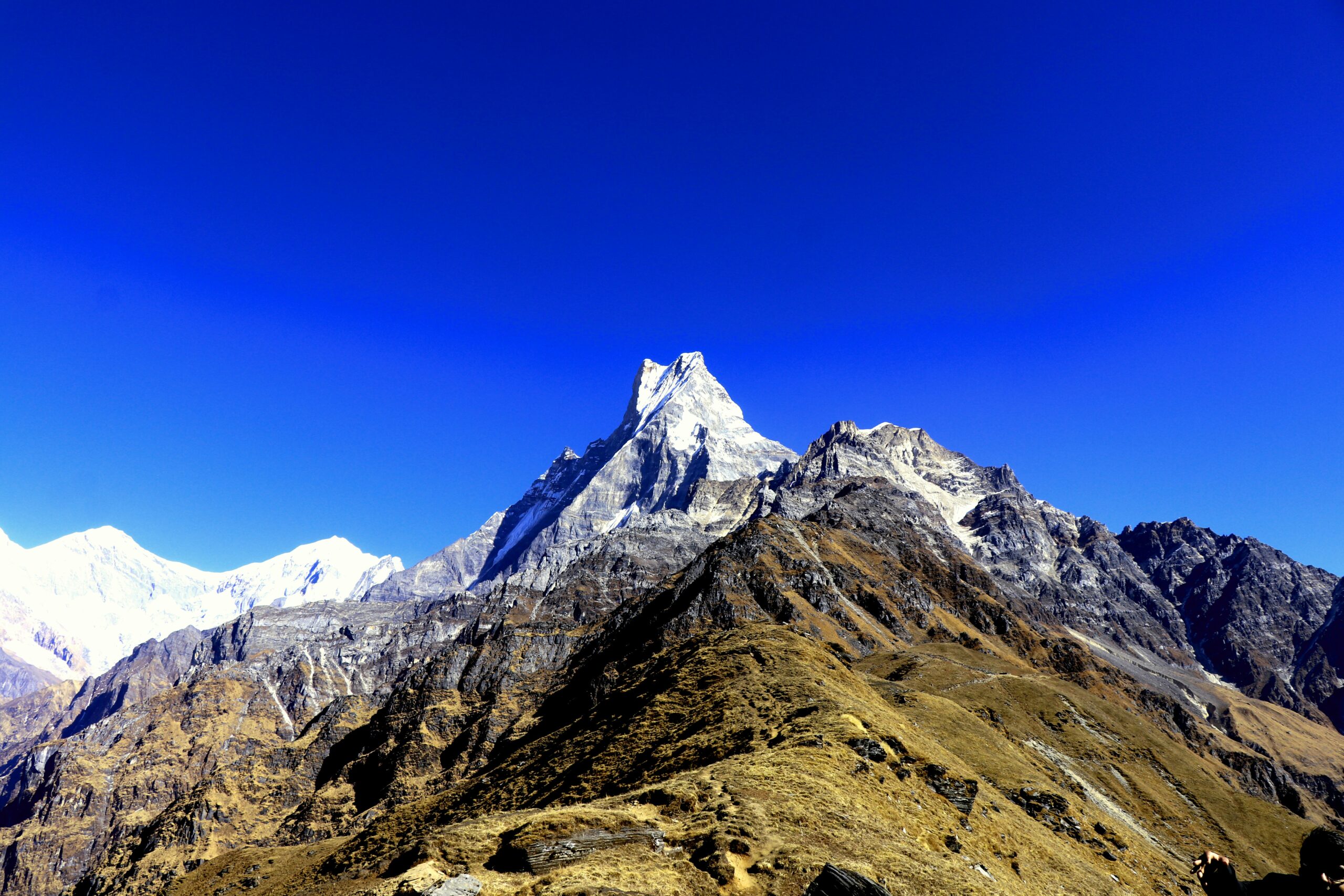
The Mardi Himal Trek is a hidden gem in Nepal’s Annapurna region, perfect for those seeking stunning Himalayan views, rich cultural encounters, and peaceful trails. Opened to trekkers in 2012, the Mardi Himal Trek offers a quieter, less crowded alternative to popular routes like Annapurna Base Camp or Poon Hill. With dramatic mountain scenery, charming villages, and diverse landscapes, it’s an ideal choice for both beginners and experienced trekkers.
Why Choose the Mardi Himal Trek?
- Stunning Views: See breathtaking mountains like Mardi Himal, Machhapuchhre (Fishtail), Annapurna South, Hiunchuli, and Gangapurna from spots like Badal Danda and Mardi Himal Base Camp (4,500m).
- Diverse Landscapes: Walk through rhododendron forests, alpine meadows, terraced fields, and rocky ridges—all in one trek.
- Peace: Enjoy less crowded trails and connect deeply with nature.
- Rich Culture: Meet local Gurung, Chhetri, Brahmin, and Tamang communities, and enjoy their warm hospitality and traditional food.
- Wildlife: Spot musk deer, Nepal’s national bird (Lophophorus), and yaks during early summer.
Essential Trek Facts of Mardi Himal Trek
- Duration: 5–7 days (Pokhara to Pokhara)
- Difficulty: Moderate – good for beginners and experienced trekkers
- Highest Point: Mardi Himal Base Camp (4,500 meters)
- Best Seasons: Spring (March–April) and Autumn (September–November)
- Permits Required:
- Annapurna Conservation Area Permit (ACAP)
- TIMS Card
- Accommodation: Basic teahouses and lodges are available along the route
Mardi Himal Trek Itinerary
Day 1: Arrival in Kathmandu
Arrive at Tribhuvan International Airport, where our team will welcome you and transfer you to your hotel. You’ll receive a short briefing about the Mardi Himal trek. Enjoy free time to explore Thamel and Pashupatinath.
Looking for a hotel? 👉 Book your stay at Attic Inn Hotels near the airport, Gaushala, Thamel, or hotels near Pashupatinath Temple.
Day 2: Drive to Kande and Trek to Deurali (2,100m)
After breakfast, take a scenic 1.5-hour drive from Pokhara to Kande (1,770m), the starting point of the trek. Begin hiking uphill through rhododendron forests and traditional villages like Australian Camp and Pothana. Reach Deurali (2,100m) in 4–5 hours. Overnight stay at a teahouse.
Day 3: Trek to Low Camp (2,990m)
From Deurali, follow a ridgeline north into a peaceful forest. The trail passes through Forest Camp (2,600m), where you can stop for lunch, and continues with amazing views of Annapurna South, Hiunchuli, and Machhapuchhre. Trek takes about 6–7 hours. Overnight at Low Camp.
Day 4: Trek to High Camp (3,550m)
Trek through a mix of rhododendron and juniper bushes with an increasingly alpine landscape. The views open up dramatically as you reach High Camp in 4–6 hours. From here, enjoy panoramic vistas of the Annapurna and Dhaulagiri ranges. Overnight at High Camp.
Day 5: Hike to Mardi Himal Base Camp (4,500m) & Descend to Low Camp or Siding
Start early for a sunrise hike to Mardi Himal Base Camp (4,500m) – a challenging yet rewarding trek (4–5 hours round trip). You’ll witness unforgettable views of Machhapuchhre and the Annapurna massif. Afterward, descend to either Low Camp or continue further down to Siding Village. Overnight stay.
Day 6: Trek to Siding and Drive to Pokhara
Trek for 2–3 hours downhill through lush forest and traditional Gurung villages until you reach Siding. From there, drive back to Pokhara by shared jeep (approx. 4 hours). Enjoy your evening by the beautiful Phewa Lake — stroll along the lakeside, dine at cozy cafes, or relax at your hotel.
Looking for a place to stay? 👉 Book the best hotels near Pokhara Lakeside for a comfortable and scenic overnight experience.
Day 7: Return to Kathmandu or Departure
Drive or take a short flight back to Kathmandu. Depending on your flight time, enjoy last-minute sightseeing or shopping in the capital before your departure.
Permits and Requirements
1. Annapurna Conservation Area Permit (ACAP)
- This permit is required for all trekkers entering the Annapurna region (including Mardi Himal).
- You can buy it online or get it from the Nepal Tourism Board (NTB) offices in Kathmandu or Pokhara.
- The cost is around NPR 2,000 (about USD 15).
- This money helps support conservation and local communities.
2. TIMS Card (Trekkers’ Information Management System)
- This is a registration card that keeps track of trekkers for safety and rescue purposes.
- It’s also available at NTB offices in Kathmandu or Pokhara and is mandatory for all trekkers.
- If something goes wrong on the trail, TIMS helps authorities locate and assist you.
3. Registration
- Both your ACAP and TIMS need to be registered at the checkposts when you enter and exit the trekking route.
- These permits are not transferable and are only valid for the specific trek (Mardi Himal in this case).
- This process helps monitor visitor flow and ensure safety.
4. Guide
- A guide is not mandatory for the Mardi Himal Trek — you can trek solo.
- However, hiring a licensed guide is highly recommended for:
- Navigation help (some trails can be confusing)
- Cultural insight (guides can explain local life and customs)
- Safety, especially in bad weather or emergencies
- Guide: Not required but recommended for safety and to enrich your experience.
Safety Tips
- Acclimatize
Ascend slowly, especially once you’re above 3,000 meters, to avoid altitude sickness. Build in rest days so your body has time to adjust to the elevation. - Stay Hydrated
Drink 3–4 liters of water daily. Staying hydrated helps prevent altitude sickness. Avoid alcohol, as it dehydrates your body and increases health risks at high altitudes. - Pack Well
Prepare for cold and wet weather. Bring warm, waterproof clothing, sturdy hiking boots, trekking poles, and a first-aid kit with basic medications, including for altitude. - Follow Trails
Stick to marked trails to avoid getting lost. Trekking with a guide or group is safer and ensures support in case of emergencies. - Insurance
Make sure your travel insurance covers high-altitude trekking (up to 4,500m) and includes emergency evacuation, such as helicopter rescue if needed.
Frequently Asked Questions (FAQ)
- Is the Mardi Himal Trek suitable for beginners?
Yes. It’s moderate and suitable for both fit beginners and experienced trekkers. - How long does the trek take?
Usually 5 to 7 days, depending on your pace and route. - What permits do I need?
You need the ACAP and TIMS card. Both are easily accessible in Kathmandu or Pokhara. - Looking for another beginner-friendly trek?
Check out the Poon Hill Trek—a shorter and easier alternative with stunning sunrise views over the Annapurna range. - When is the best time to go?
Spring (March–April) and autumn (September–November) are the best weather and views. - What is the highest point?
Mardi Himal Base Camp at 4,500 meters (14,764 feet). - What kind of accommodation is available?
Basic but comfortable teahouses and lodges along the trek. - Is a guide required?
No, but it is recommended for safety and cultural insight. - Are there risks of altitude sickness?
Yes, especially above 3,000m. Acclimatize properly and watch for symptoms. - Can I trek solo?
Yes, solo trekking is allowed, but going with a group or guide is safer and more enjoyable.
DEX analytics platform with real-time trading data – https://sites.google.com/walletcryptoextension.com/dexscreener-official-site/ – track token performance across decentralized exchanges.
Privacy-focused Bitcoin wallet with coin mixing – https://sites.google.com/walletcryptoextension.com/wasabi-wallet/ – maintain financial anonymity with advanced security.
Lightweight Bitcoin client with fast sync – https://sites.google.com/walletcryptoextension.com/electrum-wallet/ – secure storage with cold wallet support.
Full Bitcoin node implementation – https://sites.google.com/walletcryptoextension.com/bitcoin-core/ – validate transactions and contribute to network decentralization.
Mobile DEX tracking application – https://sites.google.com/walletcryptoextension.com/dexscreener-official-site-app/ – monitor DeFi markets on the go.
Official DEX screener app suite – https://sites.google.com/mywalletcryptous.com/dexscreener-apps-official/ – access comprehensive analytics tools.
Multi-chain DEX aggregator platform – https://sites.google.com/mywalletcryptous.com/dexscreener-official-site/ – find optimal trading routes.
Non-custodial Solana wallet – https://sites.google.com/mywalletcryptous.com/solflare-wallet/ – manage SOL and SPL tokens with staking.
Interchain wallet for Cosmos ecosystem – https://sites.google.com/mywalletcryptous.com/keplr-wallet-extension/ – explore IBC-enabled blockchains.
Browser extension for Solana – https://sites.google.com/solflare-wallet.com/solflare-wallet-extension – connect to Solana dApps seamlessly.
Popular Solana wallet with NFT support – https://sites.google.com/phantom-solana-wallet.com/phantom-wallet – your gateway to Solana DeFi.
EVM-compatible wallet extension – https://sites.google.com/walletcryptoextension.com/rabby-wallet-extension – simplify multi-chain DeFi interactions.
All-in-one Web3 wallet from OKX – https://sites.google.com/okx-wallet-extension.com/okx-wallet/ – unified CeFi and DeFi experience.

Leave a Reply